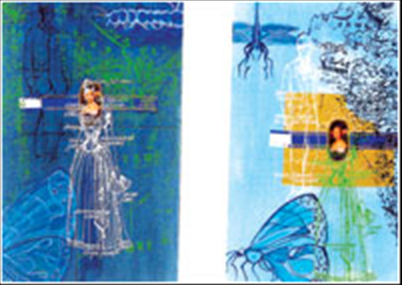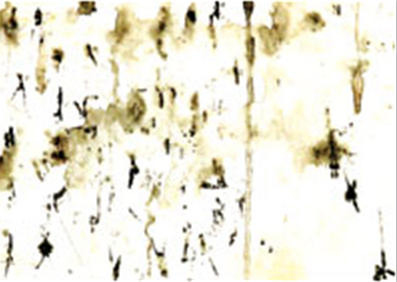Naima Dadabhoy
(Created page with "{| class="wikitable" |- |colspan="0"|<div style="font-size:100%"> This is a collection of articles archived for the excellence of their content.<br/>You can help by converting...") |
(→Naima Dadabhoy) |
||
| Line 21: | Line 21: | ||
[http://dawn.com/ Dawn] | [http://dawn.com/ Dawn] | ||
| − | |||
[[File:Naima Dadabhoy.png| Naima Dadabhoy |frame|500px]] | [[File:Naima Dadabhoy.png| Naima Dadabhoy |frame|500px]] | ||
Revision as of 09:20, 16 October 2013
This is a collection of articles archived for the excellence of their content. Readers will be able to edit existing articles and post new articles directly |
Naima Dadabhoy
Unbiased documentation
By Shamim Akhter
Naima Dadabhoy’s new body of artwork displayed at Canvas Gallery, Karachi includes 33 mixed media screen and handprints on paper. As a visual experience, the works can be divided in two groups; paintings in lighters tones with visible images, and experimental abstract works executed with Indian ink, coffee and fungus.
A part of the work in darker tones is labelled ‘Grids’ which Dadabhoy refers to as life. She gives multiple folds to her paper and then unfolds it. What appears to be a thick cord forming grids are actually the marks of the folds.
Some of her abstract forms result from undetermined experiments. She throws Indian ink on the paper and then blows it with her breath. She also works on these forms with brush producing small circles and veins; no wonder some of these forms look like lungs.
At another place she imprints fungus on eight canvases each measuring 5x5 inches; each print comes out as an individual image. These eight images have been framed together. Next to this large frame hangs the original fungus. Its future is unpredictable which is why it is not for sale.
The other segment of Dadbhoy’s work includes organics, maps, human figures and photographs. Men and women are attired in Victorian dresses. Some of the maps are from the navigators and some represent current times as well as the colonial period. She has scratched and rescratched the maps to obscure their identity. On one of them she has collaged jute strands, reminding the viewer of the time when Pakistan had two wings. One can read Baluchistan, Hindustan etc. on the maps which refer to the artist’s emotional and conceptual concerns.
Dadabhoy’s works are her personal emotional landscapes, but for the viewer, they say a lot more. Red splashes over maps may be a reference to ethnic carnage, but to the viewer they clearly communicates destruction as a result of power madness.
While working on this issue, Dadabhoy might have been detached from artistic intention. Her element presents itself on its own and yet forms a coherent picture. Seeds of African tulips on her small scale canvases stand on their own aesthetic merit and at the same time become an integral part of the situation where Dadabhoy introduces flowers, birds and branches to create a happy mood.
Her elements are focused on external events; the events which concern her emotionally. These works redirect the viewer’s attention from the psyche of the artist on to the outside world. The lack of surface detail in some of these flat canvases provides a neutral milieu for the reflection of the colours of the environment. Dadabhoy says that her work is all about life. Her experience of life exchanges daggers and missiles for musical notes when she makes an effort to create sound space.
In one sense her works are modern history paintings that comment on current events. She uses pictures of British queens and men and women dressed up in Victorian apparels as symbols of unpredictable changes. Instead of discovering herself in the act of painting, she perpetually reconstructs herself in the process of adapting to the world. The images in her work refer to specific meanings. But they do not constitute a systematic iconography. The multiplicity of possible associations to each image in her work permits one to ‘read’ the individual elements in any number of ways at the same time.
Dadabhoy loves abstract. Many a time she paints a complete picture and then instinctively scratches it off. Her abstract expressionist landscapes try to find ways where the imagery, the material and the meaning of the painting will be more like an unbiased documentation of what she feels.
Dadabhoy is pleased to let the audience hear all the sounds of the environment and discover their inherent disorder. She titles her exhibits ‘Mapping mismanagement’. She juxtaposes found images transferred from magazines as well as events. She seeks to capture reality in all its confusion and at the same time gets nostalgic about her past memories especially when she draws a boy in blue and a girl in pink on a swing. The images and objects on canvases have specific association for the artist that is not necessarily inherent in the individual object or its context. Her materials come with internal as well as external associations.
A young Post-modern artist, Dadabhoy believes that it is the idea that matters. She mentions with pride the name of Jaintee Lal the screen printmaker, who does the labour for her.
Naima Dadabhoy seeks to capture reality in all its confusion and at the same time gets nostalgic about her past memories.


